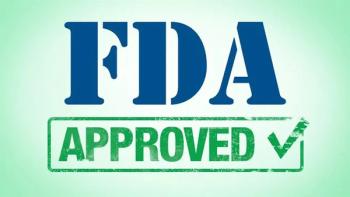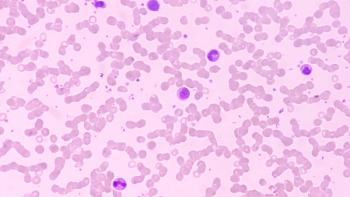
Ropeginterferon Shows Superior Outcomes in High-Risk ET
In the phase 3 SURPASS-ET trial, ropeginterferon alfa-2b outperformed anagrelide as second-line therapy for high-risk essential thrombocythemia.
Ropeginterferon alfa-2b-njft (Besremi) demonstrated greater efficacy in the second line of therapy for patients with high-risk essential thrombocythemia vs anagrelide, according to findings from the phase 3 SURPASS-ET trial (NCT04285086) presented at the 2025 SOHO Annual Meeting.1
Findings from the study showed that significantly more patients in the ropeginterferon alfa-2b arm achieved durable modified European Leukemia Net (ELN) criteria responses at months 9 and 12, compared with patients treated with anagrelide. In the ropeginterferon alfa-2b (n = 91) and the anagrelide arms (n = 83), the response rates were 42.9% and 6%, respectively (P = .0001).
“[Ropeginterferon alfa-2b] had a favorable safety profile compared [with] anagrelide, and represents a potential new therapeutic option for patients with high-risk essential thrombocythemia,” Lucia Masarova, MD, an assistant professor in the Department of Leukemia, Division of Cancer Medicine, at The University of Texas MD Anderson Cancer Center in Houston, and colleagues wrote in a poster presentation of the data.
What Were the Background and Design of the SURPASS-ET Trial?
In November 2021, the FDA approved ropeginterferon alfa-2b for the treatment of patients with polycythemia vera, based on safety findings from the PEGINVERA and PROUD/CONTINUATION-PV studies and efficacy findings from the PEGINVERA clinical study program.2 However, the agent poses as a novel interferon-based therapy for the treatment of essential thrombocythemia, as no new therapies have been approved by the FDA for the treatment of patients with essential thrombocythemia since anagrelide.1
The SURPASS-ET study evaluated ropeginterferon alfa-2b for the treatment of patients with hydroxyurea-intolerant or refractory essential thrombocythemia compared with anagrelide. The study randomly assigned 174 patients to either receive ropeginterferon alfa-2b (n = 91) or anagrelide (n = 83). Those treated with ropeginterferon alfa-2b received the agent at 250 mcg, followed by 350 mcg at week 2, and 500 mcg from week 4 every 2 weeks if tolerable.
The primary end point of the study was durable response rate at months 9 and 12 per ELN criteria; secondary end points included symptom improvement, hemorrhagic/thromboembolic events, spleen size, driver mutation allele burden, safety, and patient quality of life.
Furthermore, the modified ELN response criteria component end points included having at least a 10-point decrease in the myeloproliferative neoplasm symptom assessment form total symptom score (TSS) for at least 12 weeks, normalization of peripheral blood counts for at least 12 weeks, a disappearance of bone marrow histological abnormalities, and an absence of vascular events and disease progression.
What Were the Patient Baseline Characteristics?
In the ropeginterferon alfa-2b and anagrelide arms, respectively, the median patient ages at baseline were 61.0 years (range, 21-80) and 64.0 years (range, 20-83), and approximately half were female (51.6%; 53.0%). Notably, the median spleen size (longitudinal diameter) was 13.10 cm (range, 5.2-16.3) and 15.15 cm (range, 9.2-23.4), and the median white blood cell (WBC) count was 11.40 x 109/L (range, 7.2-47.7) and 11.60 x 109/L (range, 7.2-75.9). The most common driver mutation was in JAK2V617F (79.1%; 84.3%), and the majority of patients did not have a history of thrombosis (61.5%; 68.7%).
What Were the Additional Efficacy and Safety Data?
The response criteria by individual ELN parameters included: platelet count response, WBC count response, peripheral blood count remission, improvement or nonprogression of splenomegaly, symptom response in TSS score, and absence of hemorrhagic or thrombotic events. Specifically, in the ropeginterferon alfa-2b and anagrelide arms, respectively, the platelet count response rates were 56.0% and 21.7%, the WBC count response rates were 73.6% and 13.3%, the peripheral blood count remission response rates were 56.0% and 6.0%, the improvement or nonprogression of splenomegaly response rates were 87.9% and 54.2%, the total responses in terms of TSS score were 71.4% and 33.7%, and the absence of hemorrhagic or thrombotic events response rates were 84.6% and 51.8%.
“[There were] higher molecular response rates in terms of JAK2V617 and CALR allele reduction in the ropeginterferon alfa-2b arm,” Masarova and colleagues wrote in the poster.
Of note, a partial molecular response (PMR) in terms of allele reduction was achieved in 30.6% of patients with disease harboring JAK2V617 mutations treated with ropeginterferon alfa-2b (n = 19 of 62) compared with 0% in those treated with anagrelide with JAK2V617 (n = 42). Among patients with CALR mutations, those treated with ropeginterferon alfa-2b 10.0% achieved a PMR (n = 1 of 10), and 20.0% achieved a complete molecular response (CMR; n = 2 of 10). In a similar trend to patients with JAK2V617 mutations treated with anagrelide, 0% of patients with CALR treated with anagrelide (n = 4) achieved PMR or CMR.
Regarding safety, a significant reduction in symptoms and thrombotic or hemorrhagic events in the ropeginterferon alfa-2b arm was observed. In particular, any-grade treatment-emergent adverse effects (TEAEs) were observed in 98.9% and 96.3% of patients in the ropeginterferon alfa-2b and anagrelide arms, respectively. Grade 3 or greater TEAEs were reported in 23.1% and 33.8% of patients, respectively, with treatment-emergent serious AEs being observed in 14.3% and 30.0%, respectively. Additionally, adverse effects (AEs) of special interest were observed in 27.5% and 43.8% of patients, respectively, TEAEs leading to treatment discontinuation were observed in 5.5% and 20.0%, respectively, and AE-related deaths occurred in 0% and 3.8% of patients, respectively.
References
- Masarova L, Gill H, Zhang L, et al. Phase 3 study comparing ropeginterferon alfa-2b with anagrelide as second-line treatment for essential thrombocythemia: SURPASS-ET trial. Presented at: 2025 SOHO Annual Meeting; September 3-6, 2025; Houston, TX. Abstract MPN-524.
- US FDA approves Besremi (ropeginterferon alfa-2b-njft) as the only interferon for adults with polycythemia vera. News release. PharmaEssentia. November 12, 2021. Accessed September 25, 2025. https://us.pharmaessentia.com/wp-content/uploads/2021/11/BESREMi-FDA-Approval-November-12-2021.pdf
Newsletter
Knowledge is power. Don’t miss the most recent breakthroughs in cancer care.



















































































